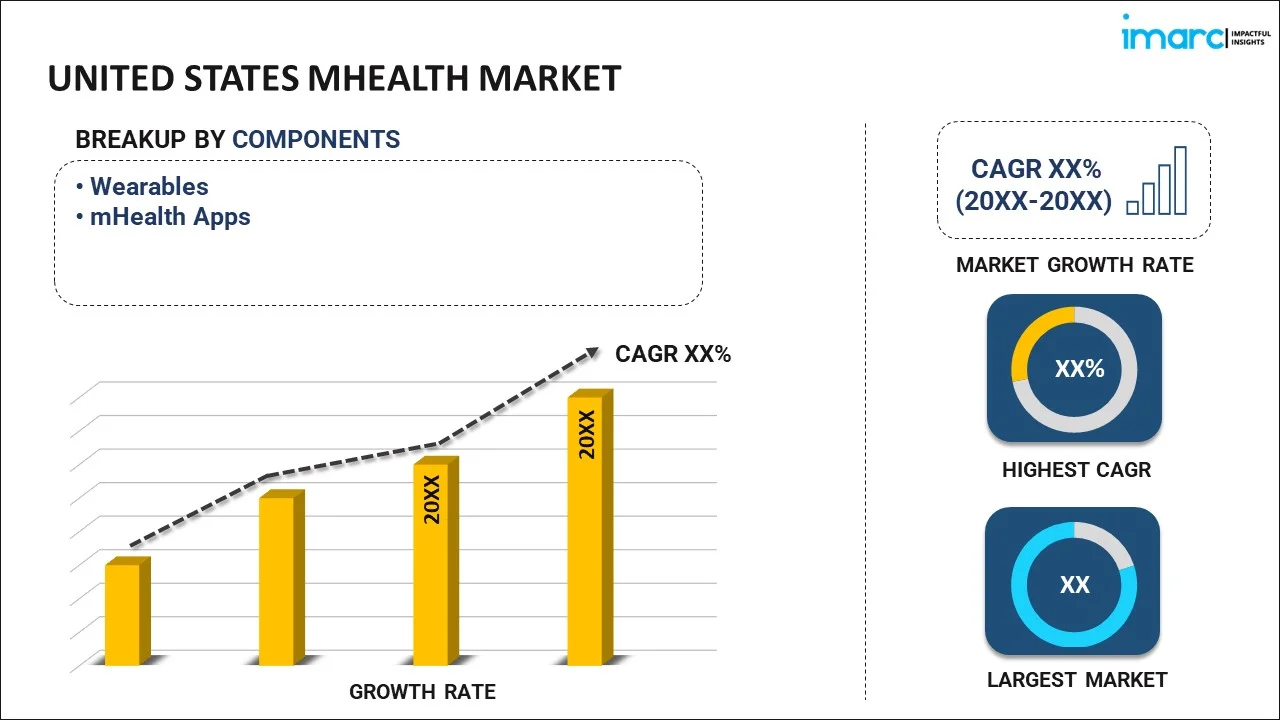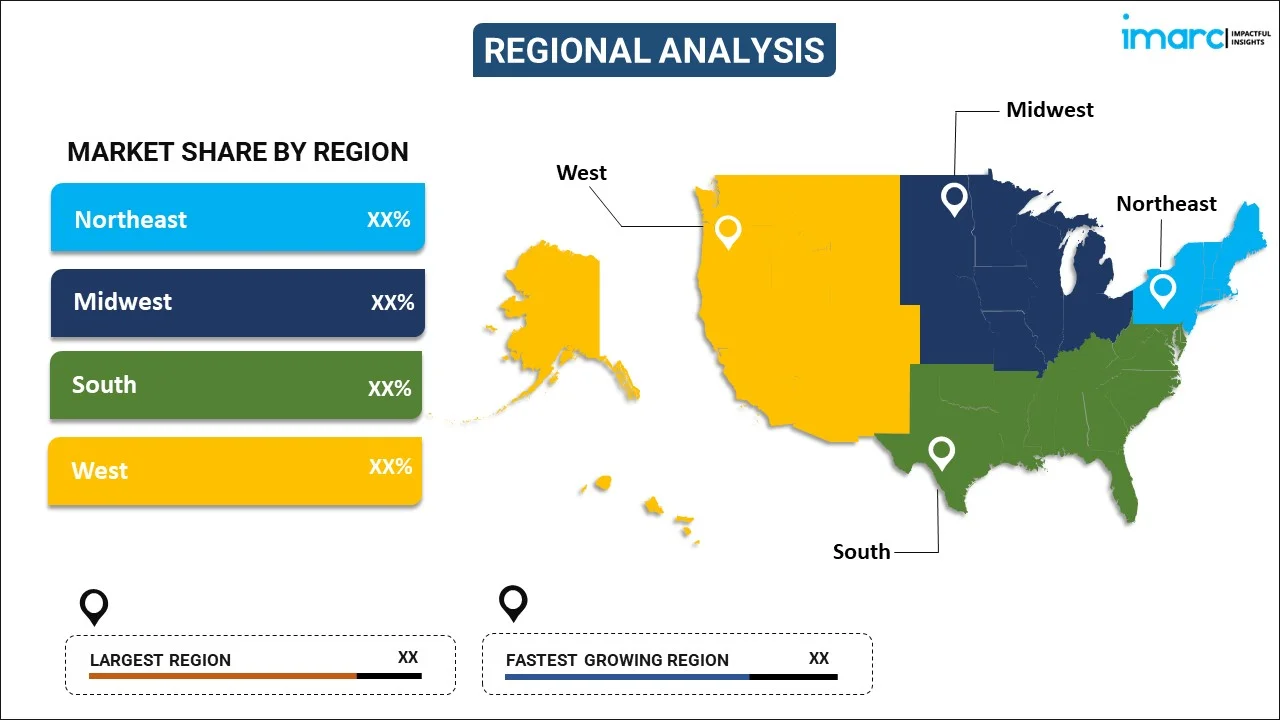
United States mHealth Market Report by Component (Wearables, mHealth Apps), Service (Monitoring Services, Diagnosis Services, Healthcare Systems Strengthening Services, Treatment Services, and Others), Participants (mHealth Application Companies, Pharmaceuticals Companies, Hospitals, Health Insurance Companies, and Others), and Region 2025-2033
Market Overview:
United States mHealth market size reached USD 22.5 Billion in 2024. Looking forward, IMARC Group expects the market to reach USD 68.8 Billion by 2033, exhibiting a growth rate (CAGR) of 13.2% during 2025-2033. The rising demand for wearable devices, such as fitness trackers and smartwatches, which have become increasingly sophisticated, incorporating health monitoring features, is driving the market.
|
Report Attribute
|
Key Statistics
|
|---|---|
|
Base Year
|
2024 |
|
Forecast Years
|
2025-2033
|
|
Historical Years
|
2019-2024
|
| Market Size in 2024 | USD 22.5 Billion |
| Market Forecast in 2033 | USD 68.8 Billion |
| Market Growth Rate (2025-2033) | 13.2% |
mHealth, short for mobile health, refers to the use of mobile devices such as smartphones, tablets, and wearables in the field of healthcare. It encompasses a wide range of applications and services that leverage wireless technology to enhance medical and public health practices. mHealth facilitates communication between patients and healthcare providers, allowing for remote monitoring, diagnosis, and treatment. This technology enables access to health information, promotes health education, and supports healthcare delivery in resource-constrained environments. With the proliferation of mobile devices, mHealth has the potential to improve healthcare accessibility, reduce costs, and empower individuals to actively participate in managing their well-being. It plays a crucial role in preventive care, chronic disease management, and emergency response, contributing to the evolution of more efficient and patient-centric healthcare systems.
United States mHealth Market Trends:
The mHealth market in the United States is experiencing robust growth, primarily driven by the increasing penetration of smartphones and the widespread availability of mobile networks. With the regional surge in smartphone adoption, mHealth applications have gained unprecedented traction, providing users with convenient access to healthcare services anytime, anywhere. Moreover, the escalating prevalence of chronic diseases has propelled the demand for remote monitoring solutions, encouraging the development of innovative mHealth technologies. Furthermore, the growing emphasis on preventive healthcare and the rising awareness of personal well-being have spurred the adoption of health and fitness apps, contributing significantly to the expansion of the mHealth market. In addition, governments and healthcare organizations in the United States are increasingly recognizing the potential of mHealth in improving healthcare delivery and outcomes, thereby fostering supportive regulatory environments and investments in infrastructure. Additionally, the integration of advanced technologies such as artificial intelligence and wearable devices into mHealth solutions, which offer personalized and data-driven healthcare experiences, is expected to drive the mHealth market in the United States during the forecast period.
United States mHealth Market Segmentation:
IMARC Group provides an analysis of the key trends in each segment of the market, along with forecasts at the country levels for 2025-2033. Our report has categorized the market based on component, service, and participants.
Component Insights:

- Wearables
- Blood Pressure Monitors
- Blood Glucometer
- Pulse Oximeter
- Neurological Monitors
- Others
- mHealth Apps
- Medical Apps
- Fitness Apps
The report has provided a detailed breakup and analysis of the market based on the component. This includes wearables (blood pressure monitors, blood glucometer, pulse oximeter, neurological monitors, and others) and mHealth Apps (medical apps and fitness apps).
Service Insights:
- Monitoring Services
- Diagnosis Services
- Healthcare Systems Strengthening Services
- Treatment Services
- Others
A detailed breakup and analysis of the market based on the service also been provided in the report. This includes monitoring services, diagnosis services, healthcare systems strengthening services, treatment services, and others.
Participants Insights:
- mHealth Application Companies
- Pharmaceuticals Companies
- Hospitals
- Health Insurance Companies
- Others
The report has provided a detailed breakup and analysis of the market based on the participants. This includes mHealth application companies, pharmaceuticals companies, hospitals, health insurance companies, and others.
Regional Insights:

- Northeast
- Midwest
- South
- West
The report has also provided a comprehensive analysis of all the major regional markets, which include Northeast, Midwest, South, and West.
Competitive Landscape:
The market research report has also provided a comprehensive analysis of the competitive landscape. Competitive analysis such as market structure, key player positioning, top winning strategies, competitive dashboard, and company evaluation quadrant has been covered in the report. Also, detailed profiles of all major companies have been provided.
United States mHealth Market Report Coverage:
| Report Features | Details |
|---|---|
| Base Year of the Analysis | 2024 |
| Historical Period | 2019-2024 |
| Forecast Period | 2025-2033 |
| Units | Billion USD |
| Scope of the Report | Exploration of Historical and Forecast Trends, Industry Catalysts and Challenges, Segment-Wise Historical and Predictive Market Assessment:
|
| Components Covered |
|
| Services Covered | Monitoring Services, Diagnosis Services, Healthcare Systems Strengthening Services, Treatment Services, Others |
| Participants Covered | mHealth Application Companies, Pharmaceuticals Companies, Hospitals, Health Insurance Companies, Others |
| Regions Covered | Northeast, Midwest, South, West |
| Customization Scope | 10% Free Customization |
| Post-Sale Analyst Support | 10-12 Weeks |
| Delivery Format | PDF and Excel through Email (We can also provide the editable version of the report in PPT/Word format on special request) |
Key Questions Answered in This Report:
- How has the United States mhealth market performed so far and how will it perform in the coming years?
- What has been the impact of COVID-19 on the United States mhealth market?
- What is the breakup of the United States mhealth market on the basis of component?
- What is the breakup of the United States mhealth market on the basis of service?
- What is the breakup of the United States mhealth market on the basis of participants?
- What are the various stages in the value chain of the United States mhealth market?
- What are the key driving factors and challenges in the United States mhealth?
- What is the structure of the United States mhealth market and who are the key players?
- What is the degree of competition in the United States mhealth market?
Key Benefits for Stakeholders:
- IMARC’s industry report offers a comprehensive quantitative analysis of various market segments, historical and current market trends, market forecasts, and dynamics of the United States mhealth market from 2019-2033.
- The research report provides the latest information on the market drivers, challenges, and opportunities in the United States mhealth market.
- Porter's five forces analysis assist stakeholders in assessing the impact of new entrants, competitive rivalry, supplier power, buyer power, and the threat of substitution. It helps stakeholders to analyze the level of competition within the United States mhealth industry and its attractiveness.
- Competitive landscape allows stakeholders to understand their competitive environment and provides an insight into the current positions of key players in the market.
Need more help?
- Speak to our experienced analysts for insights on the current market scenarios.
- Include additional segments and countries to customize the report as per your requirement.
- Gain an unparalleled competitive advantage in your domain by understanding how to utilize the report and positively impacting your operations and revenue.
- For further assistance, please connect with our analysts.
 Request Customization
Request Customization
 Speak to an Analyst
Speak to an Analyst
 Request Brochure
Request Brochure
 Inquire Before Buying
Inquire Before Buying




.webp)




.webp)












